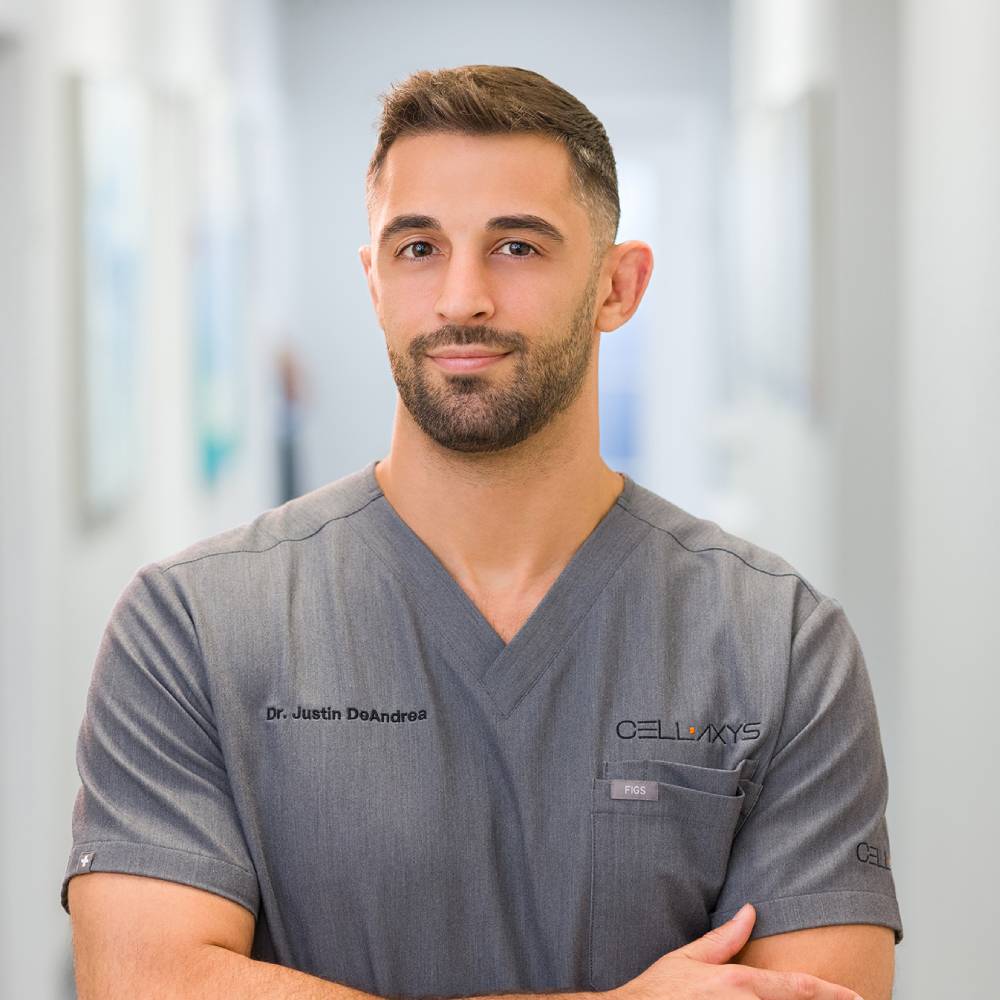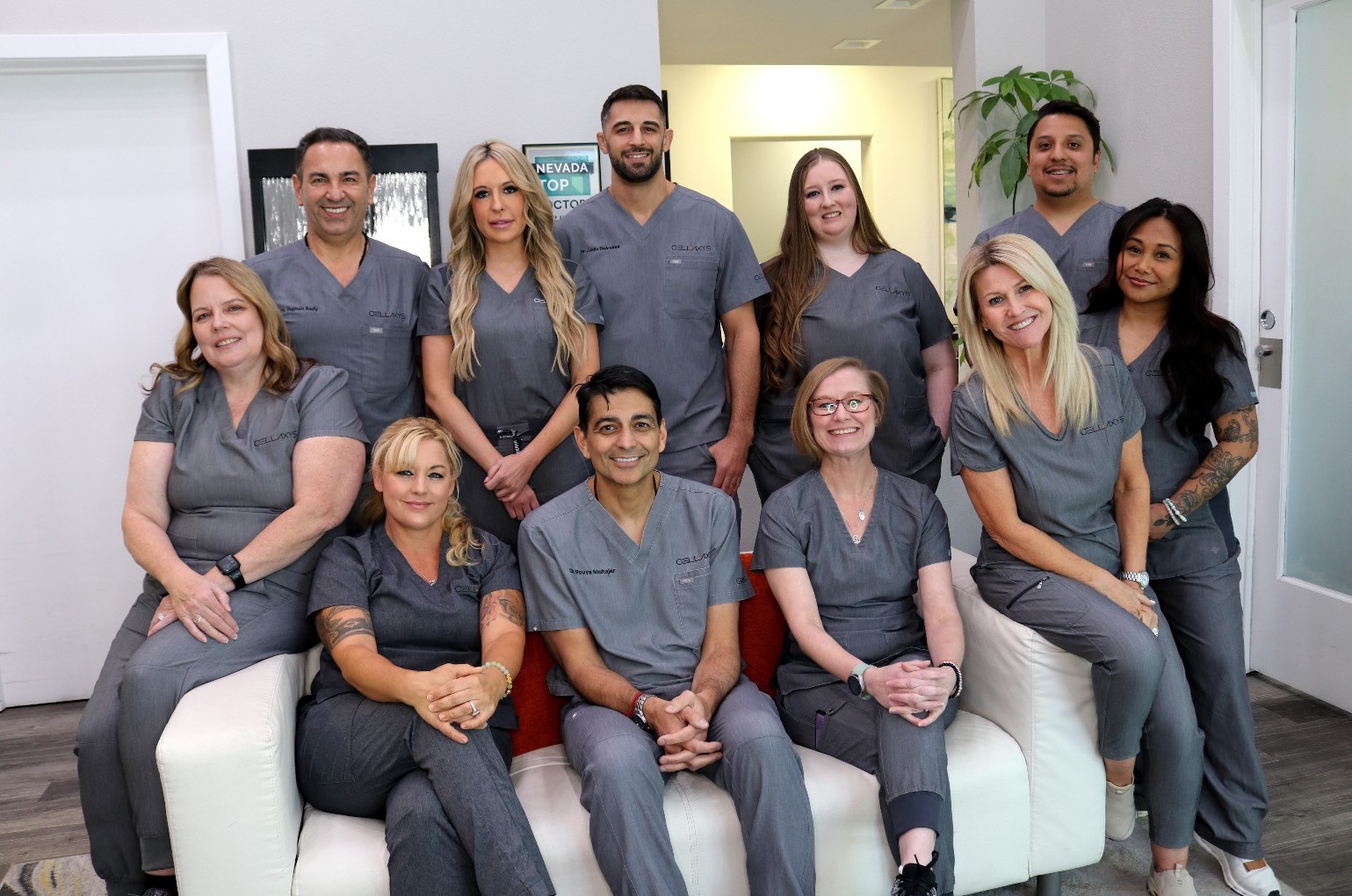Do You Have Lower Back Pain?
Consider CELLAXYS Lower Back Therapy® – minimally invasive, naturally regenerative lower back pain treatment without surgery.
The CELLAXYS team concentrates on you so you can concentrate on healing.
What causes lower back pain?
In most of the cases, lower back pain comes from mechanical issues and soft tissue injuries. Due to how interconnected spine is with the nervous system, the pain can be paralyzing: even the simplest of tasks can become a challenge, while traveling and sports quickly become out-of-the-question activities. Here are some of the most common causes:
- Degenerative and herniated discs. The spine is made out of 30 small bones, each of them separated by a spongy piece of cartilage—a disc. The lower third of the spine holds the most bodyweight, which causes the discs to wear away or rupture, resulting in sharp and chronic pain.
- Spondylolisthesis. A condition when the spinal bones are dislocated due to natural wear and tear of your joints and ligaments. This is common among older patients. Dislocated bones can press on the spinal nerves, causing lower back pain.
- Spinal stenosis. A condition typically developed as a result of osteoarthritis. The spinal bones narrow around the spinal cord, pressing on the spinal nerves, causing pain and discomfort.
Dr. Mohajer Explains Causes and Treatment of Lower Back Pain
Lower back pain is extremely common. With most professionals living sedentary lives, it is important to understand where does this pain come from, how to prevent it, and what to do about it. Surgery, however, should be the last option to consider, as explained by Dr. Mohajer.
Want to learn how Stem Cell Therapy can help you reduce your lower back pain?
Spinal Surgery
For years now, the general consensus was that to address serious hip problems, one has to go under the knife, despite the risks of a major surgery. New evidence, however, puts into question the main value proposition of surgery: namely, its quickness and effectiveness. Here are a few studies that test how effective surgery really is in addressing hip problems:
- In 2018, a study with 26 patients measured the effectiveness of surgical treatment for the Tennis elbow. It found that the surgery was no more effective than a placebo treatment within a 5 year period after the surgery, a 2012 study found
- What is more, another 2018 study has found that most alternative non-surgical elbow treatments, such as steroid injections, physical therapy, acupuncture and anti-inflammatories also ineffective in relieving elbow pain
- When treating simple elbow dislocation there is little evidenc that a surgery helps patients relieve the pain, increase the range of elbow motion, or prevent chronic instability

CELLAXYS Lower Back Therapy® employs minimally invasive treatments that enhance your body’s ability to heal itself—like stem cell therapy, to naturally regenerate the damaged spine area.


Stem Cell Therapy Powering Top Athletes
For years now, forms of stem cell therapy have been used by top athletes in adjunction to traditional orthopaedic measures—such as surgery and injections—to heal quicker and grow stronger. Since the late 1990s, a number of leading athletes, including Tiger Woods and Alex Rodriguez, have publically lead the transition away from traditional orthopaedic alternatives such as cortisone (which reduces pain quickly but damages the joint tissue irreversibly.) With long recovery times of surgery, stem cell therapy has become one of the go-to therapy methods for the sports elite.
With roots in top-level athletics, stem cell therapy focuses on safety and efficiency. Since stem cells are the natural building blocks of our body, there is virtually no risk of rejection; and the recovery time is minimal (4-6 weeks).
How Does Stem Cell Therapy Work?
Human bodies are made out of small particles called cells—nerve cells, bone cells, blood cells, muscle cells, and so on.
Stem cells are the natural ‘repair’ cells of our bodies. Their ‘job’ is to morph into a type of cell that is damaged and replace it. For example, when you suffer an injury, it is your stem cells that are trying to regenerate the damaged tissue. Stem cells are involved at every stage of human life—right from the conception.
During CELLAXYS Lower Back Therapy®, stem cells are harvested from your body, processed into a more concentrated form, and re-injected precisely into the location of the injury to repair the damage.
This way, your body’s natural healing resources are right where they’re needed most.
Stop back pain with your body’s natural regenerative cells.
We understand that this is a lot to take in, and you still probably have a lot of questions. Do not hesitate to give us a call, and we will help you out.
If you’d like to schedule a visit the CELLAXYS Therapy Center for an initial examination, please click the button below.
During the visit, our physicians will:
- Conduct a thorough physical exam
- Review your X-Ray and MRI images
- Analyze your medical history
- Give you a custom-tailored treatment plan
Meet the CELLAXYS Lower Back Therapy® Medical Staff

Dr. Pouya Mohajer
- Director of Regenerative Interventional Spine Medicine
- Board certification in Anesthesiology and Interventional Pain Medicine
- Fellowship-trained from Harvard University
- UCLA Alumni

Dr. Pejman Bady
- Medical Director
- Head of Emergency Medical Services
- Medical degree from Western University of Health Sciences
- USC Marshall School of Business

Dr. Justin DeAndrea
- Physical Medicine and Rehab trained specialist
- Medical degree from Howard University College of Medicine
Why CELLAXYS?
We take a different approach at CELLAXYS. We focus on the body’s innate ability to heal itself to not only reduce pain, but also alter the progression of pain and disease at a cellular level. Our Board-Certified & Fellowship-Trained Physicians have sub-specialized in joints and spine regenerative procedures for over a combined 60 years. Their expertise in Orthopedics, Orthobiologics and Spine & Interventional Medicine enables them to bring the process of regenerative healing to perfection.
Having done more than 30,000 procedures, we have helped our patients to live pain-free, keep their desired activity level despite age, and keep their performance up through retirement. We personalize your treatment to your exact needs on a cellular level. No injury is the same, and neither should be your treatment.
One of our lead Physicians, Dr. Matthew Otten, has been recognized as one of Nevada’s favorite physicians, winning numerous awards such as Vital’s Patient Choice Award & Most Compassionate Doctor Award. Also, Dr. Otten was recognized as part of the top 10% of America’s Most Honored Professionals by The American Registry.

Want to learn how Stem Cell Therapy
can help you reduce your lower back pain?
Want to learn how Stem Cell Therapy can help you reduce your lower back pain?
Fill out the form below to request your FREE consultation



